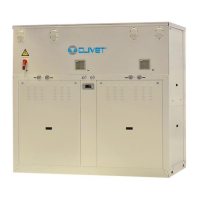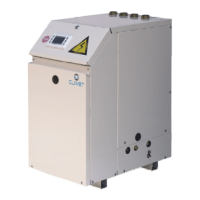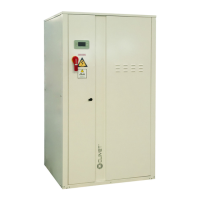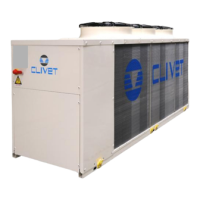Do you have a question about the CLIVET WSH Series and is the answer not in the manual?
Provides information on unit installation, use, and maintenance, along with general operating instructions and safety warnings.
Details information from the serial number label for unit identification and recommendations for anti-vibration devices.
Procedures for checking unit delivery for damage, correspondence, and safe storage.
Guidelines for safely handling the unit and removing packaging without causing damage.
Criteria for optimal positioning, sensor placement, and maintaining functional clearances for operation and maintenance.
Explains the function of the fresh air probe for optimizing unit energy efficiency.
Details essential water circuit components, operation sequence, water quality, and freeze risk prevention.
Considerations for using anti-freeze solutions and instructions for making Victaulic connections.
Illustrates recommended water circuit connection schemas for different configurations and optional features.
Details the Hydropack accessory and optional pressostatic valves for water circulation systems.
General safety, regulatory information, and data sources for electrical connections.
Details the point of entry for electric lines and specific connections to be made by the customer.
Descriptions of various electrical components like flow switches, selectors, probes, and status indicators.
Guidance on using remote controls for ON/OFF, set-point changes, and understanding operational signals.
Details on demand limit, water reset functions, and communication gateway integration.
Checklists and detailed steps required before and during the unit start-up process.
Procedures for checking refrigerant, hydraulic, and electrical circuits before unit start-up.
Checks for compressor crankcase resistances, voltages, remote controls, and operational reports.
Configuration of demand limit, water reset, and temperature/humidity probes for automatic corrections.
Description of the unit's control interface, keypad usage, and remote operation modes.
Navigation through the setup menu and procedures for managing unit alarms.
Explanation of alarm codes, structures, and status lists for central and compressor modules.
Methods for accessing and viewing system status information organized by unit modules.
Lists of general operating status parameters and those specific to compressor module 1.
Importance of scheduled maintenance, inspection frequency, and unit booklet recommendations.
Procedures for maintaining water filters, exchangers, circulation pumps, and control boards.
Guides for identifying and resolving high pressure, low pressure, and compressor protection alarms.
Procedures for safely disconnecting the unit and recovering refrigerant and anti-freeze solutions.
Instructions for unit dismantling, disposal, and compliance with the WEEE directive.
Identifies general risks, danger zones, handling, installation, and electrical part hazards.
Details risks associated with moving parts, refrigerant handling, and hydraulic components.
Detailed physical dimensions and weights for WSH-XSC 65D to 80D models.
Detailed physical dimensions and weights for WSH-XSC 85D to 120D models.
Detailed physical dimensions and weights for WSH-XSC 135E to 180F models.
Comprehensive data on cooling, heating, compressor, and exchanger performance.
Specifies operating temperature limits and sound levels for different unit configurations.
Charts showing pressure drop for evaporators, condensers, and energy recovery systems.
Correction factors for antifreeze solutions and heat exchanger fouling.
Operating pressure limits for exchangers and calibration values for control devices.











